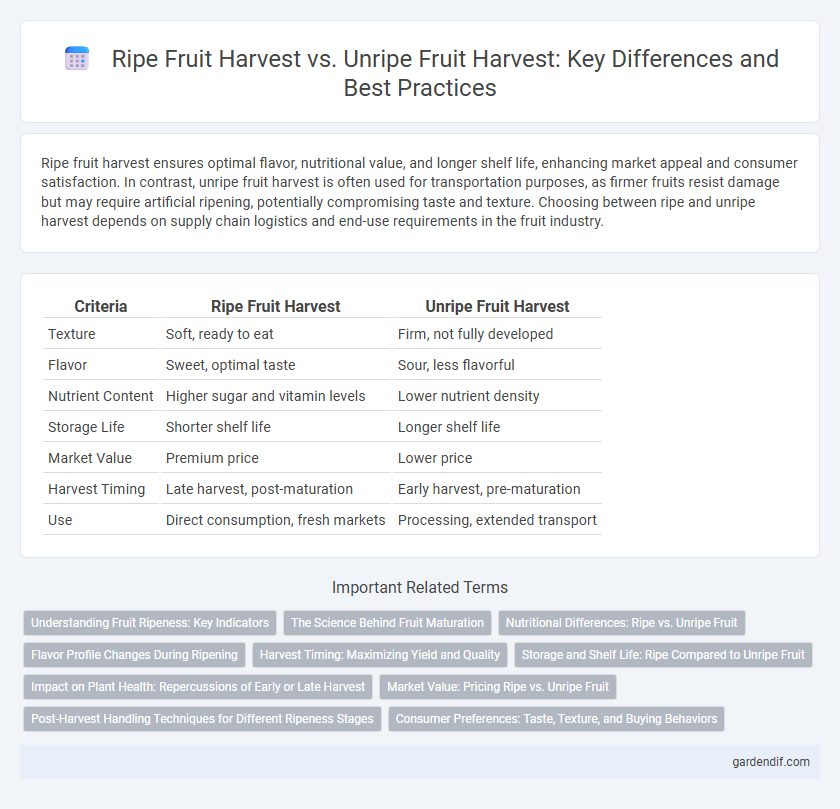
Ripe Fruit Harvest vs Unripe Fruit Harvest Illustration
Ripe fruit harvest ensures optimal flavor, nutritional value, and longer shelf life, enhancing market appeal and consumer satisfaction. In contrast, unripe fruit harvest is often used for transportation purposes, as firmer fruits resist damage but may require artificial ripening, potentially compromising taste and texture. Choosing between ripe and unripe harvest depends on supply chain logistics and end-use requirements in the fruit industry.
Table of Comparison
| Criteria | Ripe Fruit Harvest | Unripe Fruit Harvest |
|---|---|---|
| Texture | Soft, ready to eat | Firm, not fully developed |
| Flavor | Sweet, optimal taste | Sour, less flavorful |
| Nutrient Content | Higher sugar and vitamin levels | Lower nutrient density |
| Storage Life | Shorter shelf life | Longer shelf life |
| Market Value | Premium price | Lower price |
| Harvest Timing | Late harvest, post-maturation | Early harvest, pre-maturation |
| Use | Direct consumption, fresh markets | Processing, extended transport |
Understanding Fruit Ripeness: Key Indicators
Fruit ripeness is determined by key indicators such as color transformation, firmness, and aroma development, which signal optimal harvest timing for maximum flavor and nutritional value. Ripe fruit harvest ensures peak sweetness and texture, crucial for fresh consumption and processing quality, while unripe fruit harvest often results in lower sugar content and harder texture suitable for specific industrial uses or extended shelf life. Understanding these ripeness markers aids growers in making informed decisions to balance market demands and post-harvest handling.
The Science Behind Fruit Maturation
Fruit maturation involves complex physiological and biochemical changes affecting texture, flavor, and nutrient content, which are critical in determining optimal harvest time. Ripe fruit harvest maximizes sugar accumulation, flavor compounds, and nutrient density, resulting in better taste and market value. Harvesting unripe fruit interrupts these processes, often leading to poor flavor development, reduced nutrient levels, and decreased consumer appeal due to inadequate maturation.
Nutritional Differences: Ripe vs. Unripe Fruit
Ripe fruit harvests contain higher levels of natural sugars, antioxidants, and vitamins like vitamin C compared to unripe fruit harvests, which often have more starch and lower nutrient bioavailability. The enzymatic activity during ripening enhances the metabolic compounds, increasing the fruit's nutritional value and digestibility. Unripe fruits may offer more resistant starch and fiber but generally lack the full spectrum of nutrients present in ripe fruit.
Flavor Profile Changes During Ripening
Ripe fruit harvests exhibit enhanced sugar content and aromatic compounds, resulting in richer, sweeter flavors compared to unripe fruit, which tends to be more acidic and astringent. The biochemical transformation during ripening increases volatile compounds, intensifying the fruit's characteristic aroma and taste profile. Consequently, harvesting at optimal ripeness maximizes flavor complexity and consumer appeal.
Harvest Timing: Maximizing Yield and Quality
Harvest timing is critical for maximizing yield and quality, with ripe fruit harvests ensuring optimal sweetness, flavor, and nutritional content, while unripe fruit harvests may result in lower taste quality but allow for longer shelf life and reduced spoilage during transport. Farmers must monitor maturity indicators such as color, firmness, and sugar content (Brix) to determine the precise harvest window. Balancing harvest timing avoids losses from overripening or underdevelopment, enhancing both market value and consumer satisfaction.
Storage and Shelf Life: Ripe Compared to Unripe Fruit
Ripe fruit harvest offers immediate consumption with optimal flavor but generally has a shorter shelf life and more sensitive storage requirements due to higher moisture content and metabolic activity. Unripe fruit harvest extends storage potential and reduces damage during transport, as firmness and lower respiration rates help maintain quality over time. Controlled storage environments, such as temperature and humidity regulation, are critical for maximizing shelf life in both ripe and unripe fruit post-harvest.
Impact on Plant Health: Repercussions of Early or Late Harvest
Harvesting ripe fruit ensures optimal nutrient allocation and reduces stress on the plant, promoting sustained growth and higher yield in subsequent seasons. Conversely, unripe fruit harvest disrupts the plant's metabolic balance, potentially stunting development and increasing susceptibility to diseases and pests. Delayed harvest can lead to fruit overripening, which stresses the plant through prolonged resource allocation and may reduce overall plant vigor.
Market Value: Pricing Ripe vs. Unripe Fruit
Ripe fruit harvest yields higher market value due to optimal sweetness, texture, and nutritional content that meet consumer preferences, commanding premium prices. Unripe fruit generally sells at lower prices as its firmness and lack of full flavor reduce immediate market demand, often targeting processing industries or markets requiring longer shelf life. Pricing discrepancies highlight the economic advantage of harvesting at peak ripeness, despite possible logistical challenges related to fruit perishability and transport.
Post-Harvest Handling Techniques for Different Ripeness Stages
Ripe fruit harvest requires gentle handling and rapid cooling to slow down respiration and extend shelf life, while unripe fruit harvest focuses on minimizing mechanical damage and promoting controlled ripening through regulated temperature and ethylene exposure. Post-harvest techniques for ripe fruits often include immediate sorting, grading, and packaging to prevent bruising and fungal growth. In contrast, unripe fruits benefit from storage in low-temperature environments with humidity control to delay ripening until market-ready conditions are achieved.
Consumer Preferences: Taste, Texture, and Buying Behaviors
Consumers consistently prefer ripe fruit harvests due to superior sweetness, enhanced flavor profiles, and optimal texture, which directly influence purchasing decisions. Unripe fruit harvests often result in firmer, less flavorful produce that can deter buyers seeking immediate consumption quality. Retail trends indicate higher demand and willingness to pay premium prices for ripe fruit, reflecting consumer emphasis on taste and texture in buying behaviors.
Ripe Fruit Harvest vs Unripe Fruit Harvest Infographic

 gardendif.com
gardendif.com